Feature | Long Read
The (anti)Social (dis)Connection
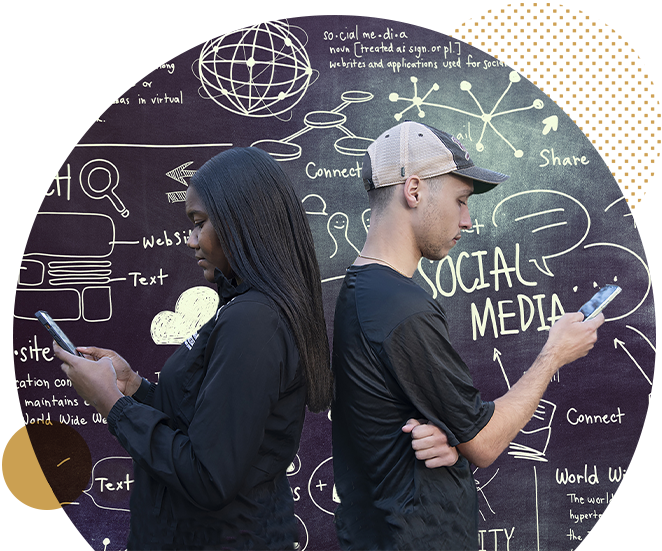
by Angela Daidone | Winter 2022
Amanda Donohue took her first steps into the social media world when she was just 12 years old. She started playing games on Facebook, sharing photos with her friends on Instagram and dabbling in most of the popular social media platforms every day.
“I grew up with it so that’s what I do,” said Amanda ’22, a graphic design major at Ramapo College. “I use them all, and I love it. It helps me feel connected.”
Amanda is not alone.
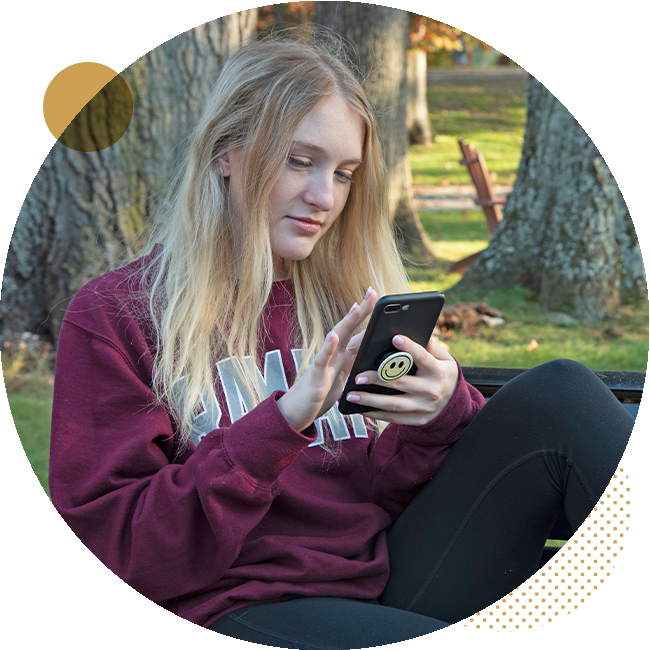
Billions of people of all ages use social media every day. A Pew Research survey this year estimated there are 2.9 billion monthly Facebook users. Other social media platforms are growing, with Instagram and TikTok each having 1 billion users. Twitter, Snapchat, YouTube and Pinterest are each attracting hundreds of millions of users, particularly people ages 18 to 29.
That age group was the original intended audience when Mark Zuckerberg and his college pals launched Facebook out of his Harvard dorm room in 2004. Fellow students could post photos of themselves and personal information about their lives, as well as share class schedules and club news. It was all about connecting with other students. Within months, more than a quarter million students from dozens of other schools signed up and the social network was on its way to becoming a worldwide phenomenon.
“Human beings are designed to connect,” said Stephanie Sarabia, Associate Professor of Social Work at Ramapo College. “Some people spend a considerable amount of their day engaged in social media. To some of those people, what they read or watch can matter very little or have a tremendous impact on their view of the world and themselves.”
Experts agree that social media are very complex.
“On one hand, social media have allowed us to find and stay in touch with people from all aspects of our lives,” said Kristen Kenneavy, Associate Professor of Sociology. “Without social media, I would almost certainly have lost touch with many of those friends, and would have no idea what was going on in their lives. So, in that sense, social media has the potential to bring people together, even if it is in a somewhat superficial way.”
However, Sarabia added that sometimes our lives are not designed to foster connection. “We can be busy, work a lot, and be stretched pretty thin at times,” which can lead to anxiety and stress that exacerbates problematic behaviors, depression, addiction, and questionable lifestyle changes. Young people are not immune to these stressors and may be more susceptible, experts say.
“Consuming social media excessively has the potential to affect a person’s self-esteem. There are only so many pictures of other people’s vacations and home makeovers one can see without starting to feel like your own life is lacking in some way,’’ said Kenneavy. “This seems particularly prevalent, as we recently learned from the congressional testimony by [Facebook] whistleblower, Frances Haugen, among young teens who are using platforms like Instagram. Constant comparison to others, especially when the comparisons are highly curated, can be detrimental to self-esteem.”
Raquia Brewster ’22, a psychology major at Ramapo, said it’s difficult for people her age to ignore those comparisons.
“There is so much emphasis on body image and trying to be the perfect person,” said Raquia. “There are apps that people use to edit their own photos to look better and set ideals. It’s not even real but at times it can be too much to handle.”
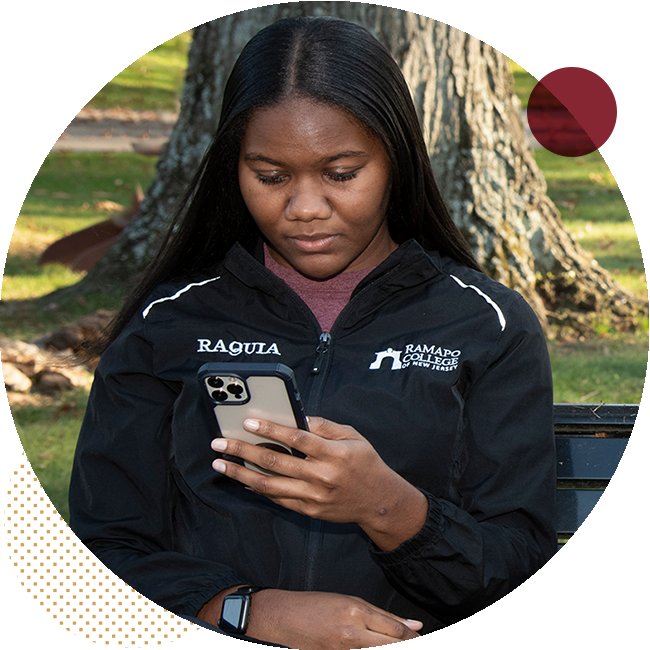
UNDERSTANDING THE (DIS)CONNECTION
Childhood and adolescence are periods of development and change, and social environments are critical in promoting that process, said Lysandra Perez-Strumolo, Associate Professor of Psychology.
“Young people do seem to be particularly susceptible to the negative effects observed in relation to social media usage, with a stable relationship observed between usage and the negative mental health outcomes such as anxiety, depression, body dissatisfaction, low self-esteem and reported loneliness,” said Perez-Strumolo.
The research on social media use is still in its infancy, Perez-Strumolo said, making it difficult to draw firm conclusions. “The challenges in studying the impact of social media relate to the inability to apply controlled experiments, which would allow us to determine with relative certainty whether the use of social media is actually causing any positive or negative effects. Most studies in this area are observational and cross-sectional, and basically compare those who use social media to those who do not.”
This leaves us with uncertainty and many questions. For example, researchers can’t prove that social media use contributes to depression, anxiety and loneliness, or whether these predispose us to more social media use — the proverbial “chicken or egg” problem, she noted. Other factors, such as socio-cultural upheaval or stress in the family and exposure to violence can contribute to excessive social media use.
Regardless of the cause, “engaging in any behavior that has a negative effect on your life or your functioning may be a problem,” Sarabia said. “That threshold is different for everyone.”
WHAT HAS GONE WRONG?
Addictive and anti-social online behavior is nothing new. But the increase in cyber bullying, online rage and posting of malicious content have alarmed healthcare professionals who express serious concerns for vulnerable young people. Haugen’s powerful testimony to Congress about Facebook’s failure to protect young people all but confirmed the validity of those concerns.
“The Facebook Papers” contained documents that showed the social media giant focused more on profits than on policing potentially harmful and often hateful content. Misinformation, or myths, are often perceived as facts. The result: An inflamed, confused and sometimes violent world of online users.
“Most adults may recognize that social media posts and marketing efforts reflect only a very narrow biased presentation of life. But children and adolescents are susceptible to the risks posed by unpoliced content,’’ said Perez-Strumolo. ‘They have not yet developed the ability to critically evaluate information and fall into unhealthy behavior.”
One of the signs that a behavior has become problematic is that it negatively impacts our lives and our bodies, said Sarabia. “If one finds themselves preoccupied throughout their day thinking about getting online or their previous time online, lying to others about the amount of time one spends online, or having one’s online time negatively impacting their relationships, work or school then it might be something to address.’’
Sarabia facilitates the Ramapo faculty-led Study Abroad Course ‘Addressing Substance Use Disorders in Lisbon, Portugal’ that introduces social work students to the European Monitoring Centre for Drugs and Drug Addiction. “The students have compiled research and participate in conferences specifically focused on behavioral internet addictions,” she said. “Students return with a deeper understanding of behavioral addictions that can be addressed in practice.”
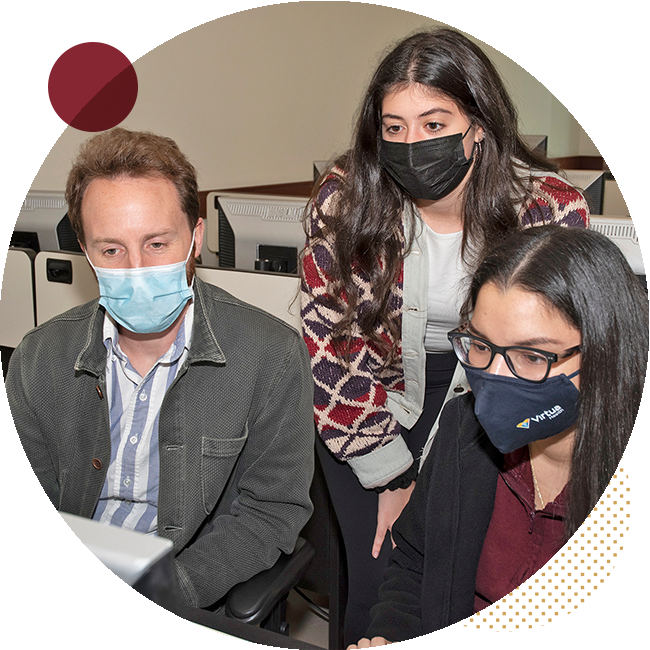
“Unsurprisingly, what social media companies’ internal documents show is that the best way to create engagement on social media platforms is through targeting the emotions of fear and anger.”
— David Gurney
Assistant Professor of Law & Society
NOT ONLY PERSONAL, IT’S BUSINESS
While the initial intent of social media platforms is to provide a space for people to connect, reconnect or just socialize, they are also business ventures that vie for more advertising dollars, increased stock values and higher worldwide profiles. Those can best be achieved with billions of users.
“The dominance of social media is not an organic phenomenon,” said David Gurney, Assistant Professor of Law & Society at Ramapo. He said that social media companies use algorithms to encourage users to spend more time on social media platforms. “Contrary to social media companies’ public pronouncements, these algorithms do not simply provide ‘best user experiences’ by showing users ‘more of what they like.’ Rather—thanks to the release of internal communications from companies like Facebook—we know that social media companies use algorithms that intentionally hijack deep aspects of human psychology.”
To accomplish this, Gurney said, social media companies have been recruiting students in doctoral programs in neuroscience, cognitive science, biology, and philosophy to build teams of PhDs who figure out how best to manipulate the human brain into spending greater time on social media.
“Unsurprisingly, what social media companies’ internal documents show is that the best way to create engagement on social media platforms is through targeting the emotions of fear and anger,” Gurney said. He cited one example of a slide from an internal Facebook presentation in 2018, which read: “Our algorithms exploit the human brain’s attraction to divisiveness.”
He said it’s no wonder that the very people who work to implement these algorithms do not let their own children anywhere near social media platforms.
More importantly, Gurney added, there are First Amendment concerns over whether social media platforms can restrict speech. “Facebook and others can kick off people who post false stories or misleading ‘news’ because they violate the terms of service,” Gurney said. “The First Amendment restricts the government’s ability to censor content—it does not apply to private businesses such as Facebook and Twitter,” Gurney said. “Yet, many commentators—and even a Supreme Court Justice—have argued that social media companies have become so dominant in our discourse that they ought to be treated as either ‘common carriers’ like telephone companies, or as ‘places of public accommodation’ who cannot discriminate against individuals based on viewpoint.” These arguments have gained little traction, he noted.
In response to the vast network of false stories and propaganda that social media companies’ algorithms pushed during the 2016 election, there was enormous pressure on these companies to better police their platforms in the lead-up to the 2020 election. “This led to companies like Facebook and Twitter taking down content—even true content—and placing warning-labels on certain posts, altering users who might read those posts to ‘vetted information,’” Gurney said.
The backlash was severe and remains a point of contention among politicians, media figures and ordinary citizens who all have expressed their discontent with Facebook and Twitter’s decision, arguing that the companies violated the First Amendment right to free speech.
However, users of platforms such as Facebook, must agree upon opening an account to its “terms of service” which state, in part, that one must not engage in conduct that is “unlawful, misleading, discriminatory or fraudulent…or infringes or violates someone else’s rights.” Users must not “share content at the expense of the safety and well-being of others or the integrity of our community.”
LIKE-MINDED USERS
Max Dubac ’22 is a communications major at Ramapo, so one would think that social media has played a big part of his academic studies. “I didn’t even have a social account until 2018,” said Max. “I had no need to use any of it.” But as his interest in sneakers – all running shoes and clothing, actually – peaked, so has his interest in networking via social platforms.
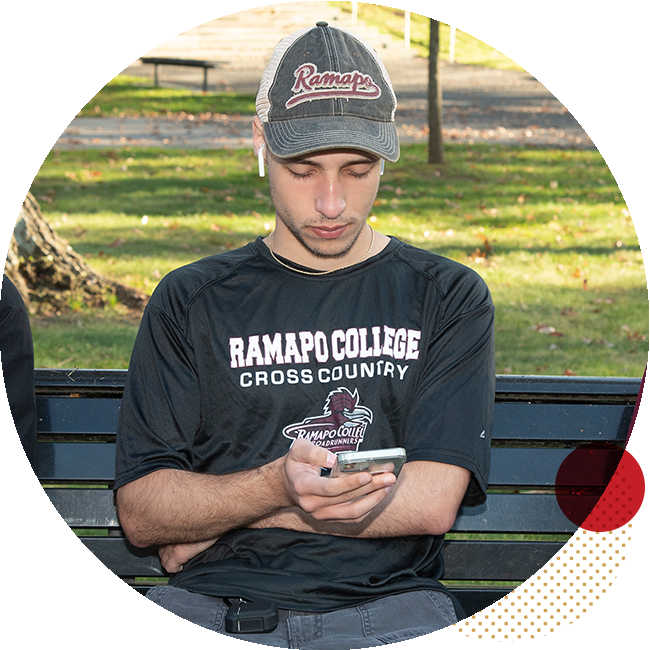
“I find other people who are interested in the same thing I am, so it works for me,” said Max, a member of the Roadrunners Cross Country and Track & Field squads. Similarly, on-campus Facebook groups, Instagram and Twitter accounts and other social media avenues have helped raise the College’s profile in many different ways. For example, students can network with potential employers; faculty can post their research; the community can get a glimpse of what is happening on campus; and alumni can reconnect with their alma mater. Good news can be shared with a simple click.
“We cannot deny the beneficial impact of digital technology and communication on our society,” said Perez-Strumolo.
“Like many things in life, social media offers us some seriously negative downsides but also incredibly positive opportunities,” says Michael Bitz, Professor of Teacher Education and Director of the Instructional Design Center. “On the positive side, social media platforms give us a chance to connect and even collaborate with people around the world both personally and professionally. There are people with whom I work very closely but have never met in person except on social media and other technology platforms. That is a truly revolutionary outcome of social media.”
In 2001, Bitz launched a literacy initiative called the Comic Book Project, where youths write, design, and publish original comic books. More than 150,000 youths and educators have participated in this non-traditional pathway to academic success.
“One of the ways that social media has impacted the Comic Book Project is in how students share their original comics, characters, and storylines with each other,” Bitz said, noting that the program was entirely virtual last year. “We launched a Ning, an invite-only social media network, for the participants. This gave the students an opportunity to meet each other online and share their work while we were able to monitor the members and make sure they were following the rules of the space: respect each other, be kind, and be supportive.”
Unfortunately, we can’t control where students access information but we can help steer them in a positive direction, he said.
“Information is literally everywhere. This means that students don’t need educators – including college professors – to lecture content and facts at them. All of the information is readily available online through a variety of modes and sources,” said Bitz. “What students do need is their teachers to help them organize, analyze, and synthesize all that information with a critical lens. This is the role of an instructional designer, something I believe more educators at every level will need to consider as part of their instructional methodologies and approaches.”
Raquia and Max agreed there are benefits of stepping away for a while – Max said that he and other students go on a “social media cleanse.”
“It’s healthy for your mental outlook and keeps you focused on the positive things that really matter,” he said.
Good news worth sharing.
The Adolescent Brain on Social Media
by Angela Daidone
It is no secret that social media play an important role in the lives of today’s young people. From a very young age, they are handed smart devices, tablets and cell phones – either to keep them occupied or distracted or, hopefully, engaged in an educational type of program. This generation is living in a media-saturated world, experts say. But those same experts are now questioning whether all that exposure is good for them, and more important, what effect is it having on the adolescent brain.
“It’s a very impressionable time for young people who are trying to discover themselves and form their own identities,” said Choudhury. “It’s interesting, however, that in doing so, they tend to follow what their peers are doing.”
— Naseem Choudhury
Professor of Psychology and Neuroscience
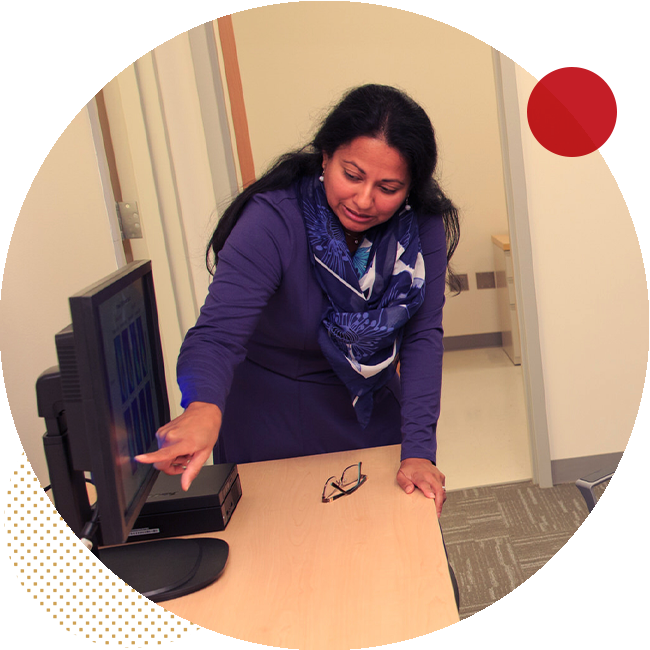
Adolescence is defined as the period between childhood and adulthood – ages 10-22 years, said Naseem Choudhury, Professor of Psychology and Neuroscience at Ramapo College. “It’s a very impressionable time for young people who are trying to discover themselves and form their own identities,” said Choudhury. “It’s interesting, however, that in doing so, they tend to follow what their peers are doing.”
Social media is playing a huge role in this identity-seeking stage of their lives. “The feeling of being connected is important. But when that connection doesn’t happen, the consequences of social rejection or isolation can be observed in the physiology of the brain, followed by a cascade of effects, both in brain and in behavior, that are not necessarily positive,” Choudhury said. For instance, adolescents who are socially isolated and who turn to social media may make poor decisions because they are seeking acceptance in quarters that are not amenable to that deep thought and critical thinking. “This doesn’t mean they can’t make a choice, but when negative feelings drive choices, those choices are often fear-based responses,” Choudhury said, adding that emotions may make adolescents susceptible to “fake news, unrealistic self-expectations or adverse use of social media.”
Choudhury said that cognitive neuroscience studies have used functional magnetic resonance imaging (fMRI) to examine how the adolescent brain changes over the course of development. The results, she said, showed that cognitive and socio-affective development is accompanied by physical changes in the adolescent brain. In other words, there is actual correlation of brain function and emotional experiences.
“The data seems to suggest that social rejection online is just as impactful – maybe more so – than face-to-face rejection or non-acceptance by other adolescents. Likewise, positive experiences can lead to a sense of well-being and self-acceptance,” said Choudhury. “Either way, it warrants our attention and further study. The goal is to help adolescents develop in a healthy and safe way.”
What They’re Saying
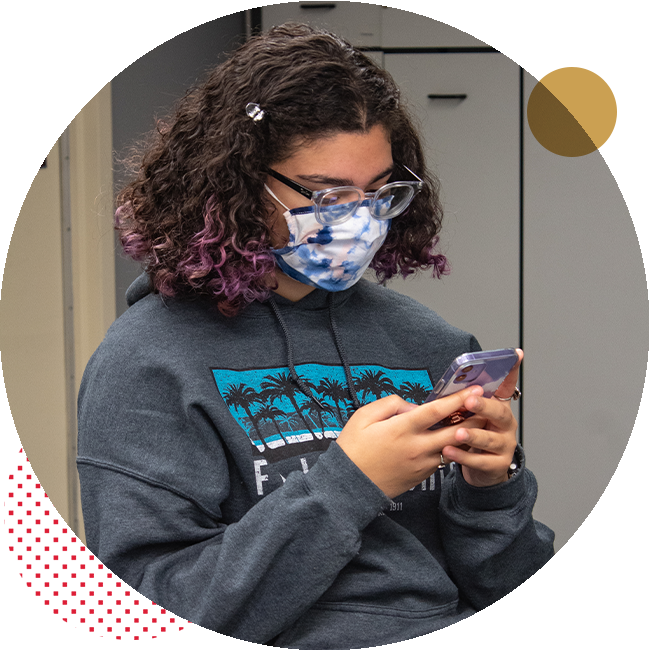
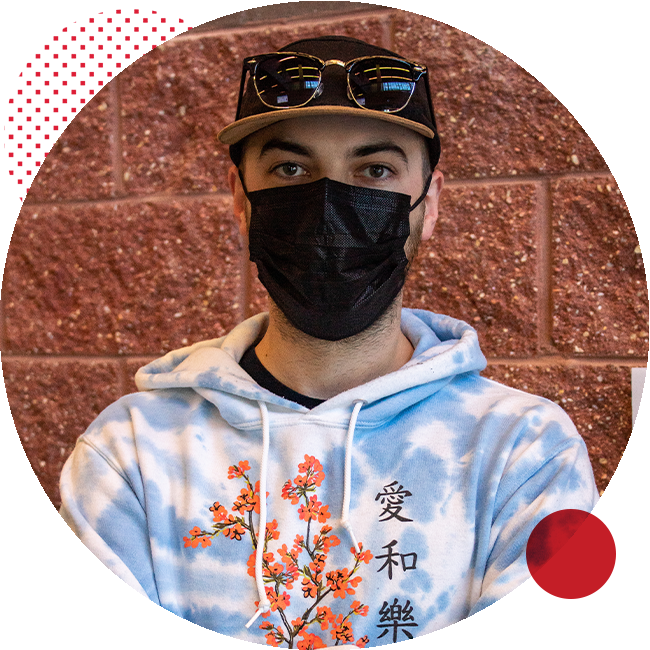
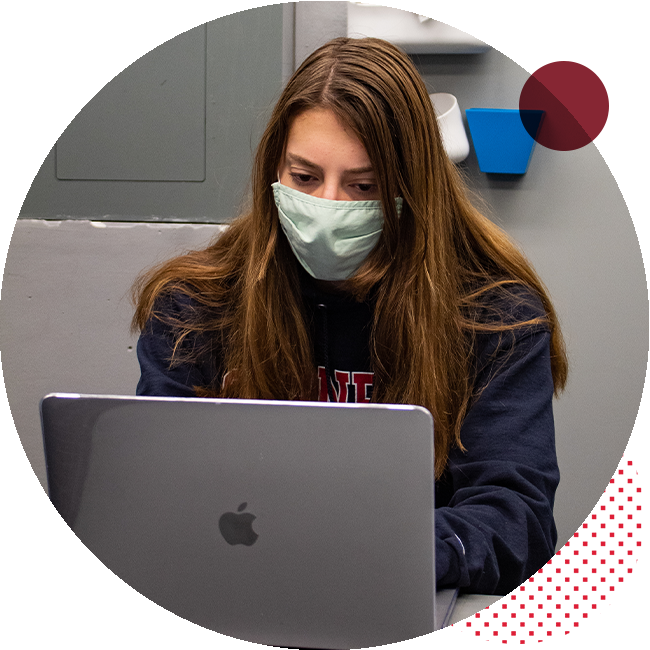
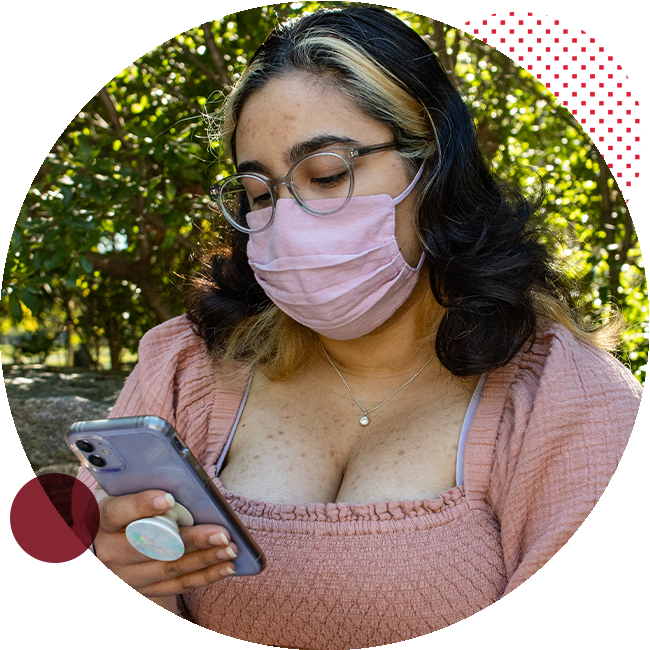
Student photographer Jennifer French ’21 asked fellow students about their social media use — how old were they when they first started using social media, why did they start and how important is it in their daily lives. Here’s what they had to say about it:
Emily Abreu ’23
“I started using social media when I was 15 because my friend in high school convinced me to get Snapchat, so that we can send videos and pictures to each other. I also use Instagram.”
Kevin Backman ’22
“I started using Instagram when I was about 14 because all my friends had it and I wanted to have what they had. Now it’s not very important to me but it does help kill time.”
Kaitlin Balasaygun ’23
“I mainly use Instagram and Snapchat. I started using social media when I was 12 years old because all of my friends were and I’d say I use some form of social media every day.”
Jade Guidry ’23
“I started using social media when I was 14 years old. I wanted to connect with friends and possibly make more friends online who shared similar interests. It was easy to connect with people like me from across the country and it just seemed so easy to do.
I mainly use is Discord as I talk to online friends through that. I also use Twitter occasionally to see what’s going on in the world. I only use Snapchat if I want to take pictures and I rarely use Instagram.”
← Back to Magazine Homepage
